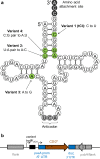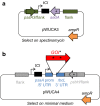CITRIC: cold-inducible translational readthrough in the chloroplast of Chlamydomonas reinhardtii using a novel temperature-sensitive transfer RNA
- PMID: 30474564
- PMCID: PMC6260665
- DOI: 10.1186/s12934-018-1033-5
CITRIC: cold-inducible translational readthrough in the chloroplast of Chlamydomonas reinhardtii using a novel temperature-sensitive transfer RNA
Abstract
Background: The chloroplast of eukaryotic microalgae such as Chlamydomonas reinhardtii is a potential platform for metabolic engineering and the production of recombinant proteins. In industrial biotechnology, inducible expression is often used so that the translation or function of the heterologous protein does not interfere with biomass accumulation during the growth stage. However, the existing systems used in bacterial or fungal platforms do not transfer well to the microalgal chloroplast. We sought to develop a simple inducible expression system for the microalgal chloroplast, exploiting an unused stop codon (TGA) in the plastid genome. We have previously shown that this codon can be translated as tryptophan when we introduce into the chloroplast genome a trnWUCA gene encoding a plastidial transfer RNA with a modified anticodon sequence, UCA.
Results: A mutated version of our trnWUCA gene was developed that encodes a temperature-sensitive variant of the tRNA. This allows transgenes that have been modified to contain one or more internal TGA codons to be translated differentially according to the culture temperature, with a gradient of recombinant protein accumulation from 35 °C (low/off) to 15 °C (high). We have named this the CITRIC system, an acronym for cold-inducible translational readthrough in chloroplasts. The exact induction behaviour can be tailored by altering the number of TGA codons within the transgene.
Conclusions: CITRIC adds to the suite of genetic engineering tools available for the microalgal chloroplast, allowing a greater degree of control over the timing of heterologous protein expression. It could also be used as a heat-repressible system for studying the function of essential native genes in the chloroplast. The genetic components of CITRIC are entirely plastid-based, so no engineering of the nuclear genome is required.
Keywords: Chloroplast; Inducible expression; Industrial biotechnology; Microalgae; Opal suppression; Premature termination codon; tRNA.
Figures






Similar articles
-
Codon reassignment to facilitate genetic engineering and biocontainment in the chloroplast of Chlamydomonas reinhardtii.Plant Biotechnol J. 2016 May;14(5):1251-60. doi: 10.1111/pbi.12490. Epub 2015 Oct 15. Plant Biotechnol J. 2016. PMID: 26471875 Free PMC article.
-
Mechanisms governing codon usage bias and the implications for protein expression in the chloroplast of Chlamydomonas reinhardtii.Plant J. 2022 Nov;112(4):919-945. doi: 10.1111/tpj.15970. Epub 2022 Oct 19. Plant J. 2022. PMID: 36071273 Free PMC article. Review.
-
Selection on the codon bias of Chlamydomonas reinhardtii chloroplast genes and the plant psbA gene.J Mol Evol. 1996 Jul;43(1):28-31. doi: 10.1007/BF02352296. J Mol Evol. 1996. PMID: 8660426
-
Improved heterologous protein expression in the chloroplast of Chlamydomonas reinhardtii through promoter and 5' untranslated region optimization.Plant Biotechnol J. 2011 Aug;9(6):674-83. doi: 10.1111/j.1467-7652.2011.00620.x. Epub 2011 May 2. Plant Biotechnol J. 2011. PMID: 21535358
-
Recombinant Protein Production in Microalgae: Emerging Trends.Protein Pept Lett. 2020;27(2):105-110. doi: 10.2174/0929866526666191014124855. Protein Pept Lett. 2020. PMID: 31622194 Review.
Cited by
-
Selectable Markers and Reporter Genes for Engineering the Chloroplast of Chlamydomonas reinhardtii.Biology (Basel). 2018 Oct 10;7(4):46. doi: 10.3390/biology7040046. Biology (Basel). 2018. PMID: 30309004 Free PMC article. Review.
-
An RNA thermometer in the chloroplast genome of Chlamydomonas facilitates temperature-controlled gene expression.Nucleic Acids Res. 2023 Nov 10;51(20):11386-11400. doi: 10.1093/nar/gkad816. Nucleic Acids Res. 2023. PMID: 37855670 Free PMC article.
-
The Potential of Algal Biotechnology to Produce Antiviral Compounds and Biopharmaceuticals.Molecules. 2020 Sep 4;25(18):4049. doi: 10.3390/molecules25184049. Molecules. 2020. PMID: 32899754 Free PMC article. Review.
-
The Algal Chloroplast as a Testbed for Synthetic Biology Designs Aimed at Radically Rewiring Plant Metabolism.Front Plant Sci. 2021 Sep 24;12:708370. doi: 10.3389/fpls.2021.708370. eCollection 2021. Front Plant Sci. 2021. PMID: 34630459 Free PMC article. Review.
-
Harnessing the Algal Chloroplast for Heterologous Protein Production.Microorganisms. 2022 Mar 30;10(4):743. doi: 10.3390/microorganisms10040743. Microorganisms. 2022. PMID: 35456794 Free PMC article. Review.
References
-
- Gallaher SD, Fitz-Gibbon ST, Strenkert D, Purvine SO, Pellegrini M, Merchant SS. High-throughput sequencing of the chloroplast and mitochondrion of Chlamydomonas reinhardtii to generate improved de novo assemblies, analyze expression patterns and transcript speciation, and evaluate diversity among laboratory strains and wild isolates. Plant J. 2018;93:545–565. doi: 10.1111/tpj.13788. - DOI - PMC - PubMed

